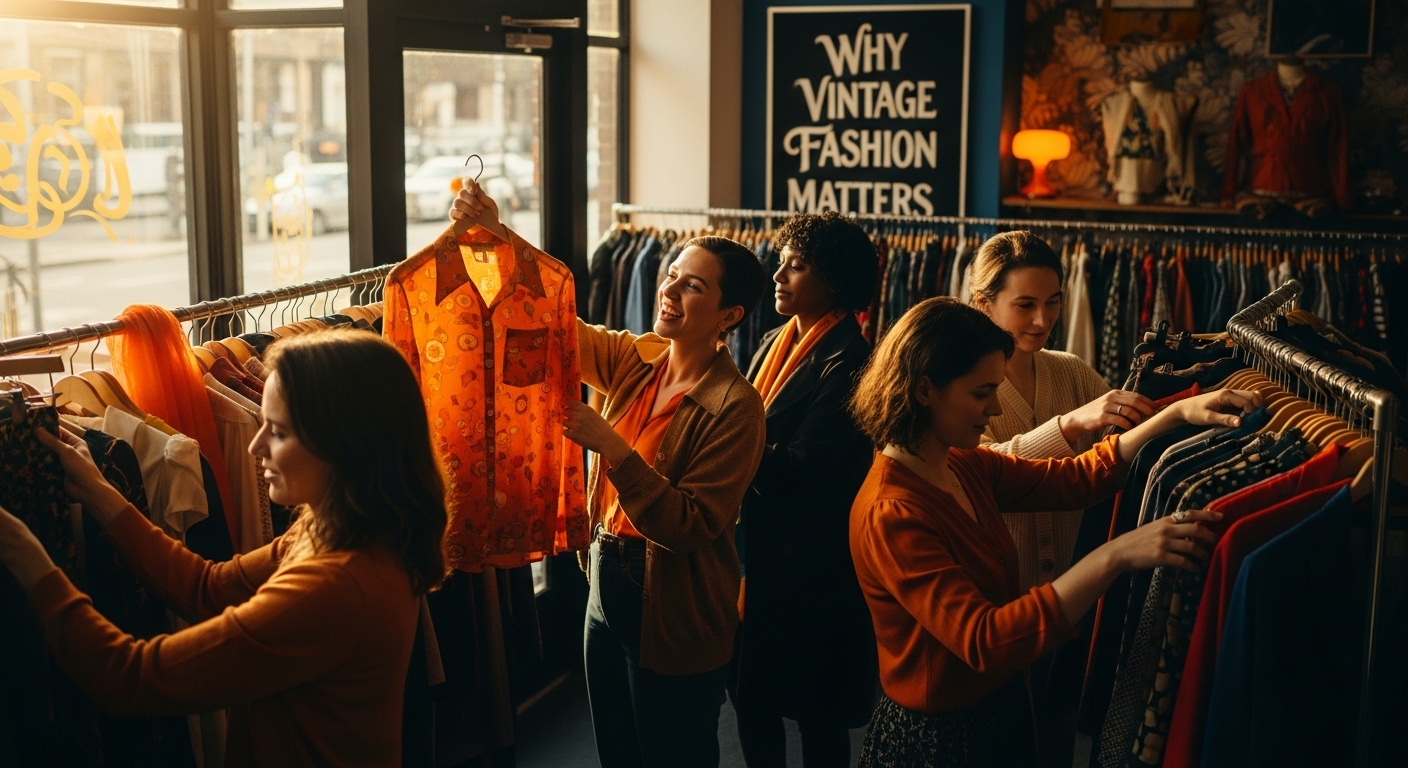Understanding Why Vintage Fashion Matters
- Emma

- Sep 18
- 8 min read

Vintage fashion seems all about quirky prints and glamorous parties from the past, with each piece echoing its own retro charm. Yet, there is something far deeper stitched into those seams. A single 1950s dress can tell the story of post-war optimism and female empowerment in ways new clothes never could. This is about living history you can actually wear, not just old clothes hanging in a shop.
Table of Contents
Quick Summary
Takeaway | Explanation |
Vintage fashion tells historical stories. | Each vintage piece showcases the cultural and social context of its era, making them much more than just clothing. |
Vintage promotes sustainability in fashion. | Choosing vintage reduces waste and environmental impact, offering a more eco-conscious alternative to fast fashion. |
Authenticity is key in vintage items. | Understanding provenance and craftsmanship is crucial for collectors to avoid modern reproductions and appreciate genuine pieces. |
Vintage influences modern fashion trends. | Contemporary designers often draw inspiration from vintage styles, intertwining historical elements into new designs. |
Wearing vintage connects with personal identity. | Vintage allows individuals to express themselves uniquely, weaving personal history with fashion choices. |
The Essence of Vintage Fashion: What is it?
Vintage fashion transcends mere clothing; it represents a profound cultural narrative woven through textiles, design, and historical significance. At its core, vintage fashion captures garments and accessories originating from specific historical periods, typically spanning from the 1920s to the 1980s, each piece telling a unique story of its era.
Defining Vintage: Beyond Simple Age
What precisely distinguishes vintage from simply being “old”? According to research from the University of Edinburgh’s Fashion Studies Department, vintage fashion is characterised by three fundamental elements:
Authenticity: Original pieces from a specific historical period
Craftsmanship: Superior manufacturing techniques and detailed construction
Cultural Significance: Garments that represent the social and aesthetic values of their time
These pieces are not just clothing but living historical artefacts that capture the aesthetic sensibilities, societal norms, and technological capabilities of their original production era. A 1950s swing dress, for instance, doesn’t merely represent a garment but embodies the post-war optimism and emerging female empowerment of that decade.
To clarify the distinctive qualities that set vintage fashion apart from simply being old, the following table summarises the fundamental elements underpinning genuine vintage clothing.
Element | Description |
Authenticity | Original pieces from a recognised historical period, not reproductions or retro-inspired designs |
Craftsmanship | Superior manufacturing techniques and detailed construction representative of the era |
Cultural Significance | Garments reflecting the social and aesthetic values of the period in which they were made |
Provenance | Traceable history and documentation verifying the item’s origin |
Period-Specific Details | Features such as fabrics, patterns, and closures unique to a specific decade |
The Emotional and Cultural Resonance of Vintage Fashion
Vintage fashion offers more than aesthetic appeal; it provides a tangible connection to history. Each carefully preserved garment serves as a textile time capsule, allowing wearers to connect with past generations and their experiences. Read more about the historical significance of vintage designers to understand how these pieces represent more than just fashion trends.
Moreover, vintage fashion represents a sustainable alternative to fast fashion, celebrating individual style while reducing environmental waste. By choosing vintage, fashion enthusiasts make a statement about consumption, craftsmanship, and personal expression that goes far beyond contemporary clothing trends.
Cultural Significance: Why Vintage Fashion Matters
Vintage fashion is more than a stylistic choice; it represents a profound cultural dialogue between past and present, revealing intricate narratives about societal evolution, personal identity, and collective memory. It serves as a powerful medium through which individuals can explore and express complex social histories.
Challenging Contemporary Fashion Narratives
Vintage clothing challenges the linear progression of fashion, offering a nuanced perspective on cultural transformation. Research from the Victoria and Albert Museum indicates that vintage fashion enables wearers to engage critically with historical aesthetic expressions, revealing how clothing communicates broader social dynamics.
Key aspects of this cultural significance include:
Resistance to Mass Production: Rejecting homogeneous contemporary fashion trends
Historical Documentation: Preserving textile craftsmanship and design heritage
Personal Storytelling: Using garments as individual expression mechanisms
Beyond Aesthetics: Social Commentary and Personal Identity
Each vintage piece embodies a microcosm of historical experience. A 1940s tailored suit, for instance, does not merely represent clothing but encapsulates wartime economic restrictions, gender role transformations, and technological manufacturing constraints of its era. Explore our collection of unique vintage pieces to witness these fascinating historical narratives firsthand.
Moreover, vintage fashion allows individuals to construct multilayered personal identities that transcend contemporary fashion’s ephemeral trends. By selecting garments from different historical periods, wearers create complex visual narratives that challenge linear understanding of personal style, demonstrating fashion’s role as a dynamic form of cultural communication and self-expression.

Sustainability in Fashion: How Vintage Supports Eco-Conscious Choices
Vintage fashion emerges as a powerful solution to the environmental challenges posed by contemporary fast fashion, offering a sustainable approach that reduces waste, conserves resources, and challenges the disposable nature of modern clothing consumption.
The Environmental Cost of Fast Fashion
The fashion industry represents a significant environmental burden, with research from the Ellen MacArthur Foundation revealing that textile production generates more carbon emissions than international maritime shipping and international flights combined. Vintage fashion directly counteracts this trend by extending the lifecycle of existing garments.
The environmental impact of fast fashion compared to the sustainable contribution of vintage clothing is highlighted in this table.
Aspect | Fast Fashion | Vintage Fashion |
Waste Production | High, due to disposable nature | Low, as clothing is reused and repurposed |
Resource Use | Consumes large amounts of new textiles, water, and energy | Conserves resources by prolonging the lifecycle of existing garments |
Carbon Footprint | Significant, with high manufacturing and shipping emissions | Minimal, as there is no new production required |
Contribution to Circular Economy | Minimal, clothing typically ends in landfill | Strong, promotes reuse and sustainability |
Key sustainability benefits of vintage fashion include:
Waste Reduction: Preventing clothing from ending up in landfills
Resource Conservation: Eliminating the need for new textile production
Carbon Footprint Minimisation: Reducing demand for new manufacturing processes
Circular Fashion and Ethical Consumption
Vintage fashion embodies the principles of circular economy, transforming clothing from a disposable commodity into a valuable, reusable resource. Check out our curated collection of sustainable vintage pieces that demonstrate how style and environmental consciousness can coexist beautifully.
By choosing vintage, consumers actively participate in a more ethical fashion ecosystem. Each pre-loved garment represents a deliberate choice to prioritise environmental stewardship over rapid consumption, challenging the pervasive throwaway culture that dominates contemporary fashion markets. This approach not only preserves unique historical designs but also significantly reduces the fashion industry’s substantial environmental impact.
The Art of Collecting: Key Concepts in Vintage Fashion
Vintage fashion collecting transcends mere accumulation, representing a sophisticated art form that demands expertise, passion, and an intricate understanding of historical textile narratives. It is a nuanced practice of curating personal museums of sartorial heritage.
Understanding Vintage Authenticity and Value
Research from York St John University reveals that vintage fashion retailers position themselves through unique expertise, emphasising the critical importance of authentication and provenance in building valuable collections. Collectors must develop a discerning eye for distinguishing genuine vintage pieces from modern reproductions.
Vintage fashion collecting requires attention to several key factors that influence an item’s value and authenticity. This table provides a concise summary of critical considerations for collectors.
Consideration | Explanation |
Provenance Documentation | Verification of garment’s origin and ownership history |
Condition Assessment | Evaluation of wear, fabric integrity, and restoration potential |
Period-Specific Details | Recognition of original manufacturing methods and design features consistent with the era |
Authenticity | Ensuring the item is a true vintage piece, not a reproduction |
Key considerations for vintage fashion collectors include:
Provenance Documentation: Tracing the historical lineage of garments
Condition Assessment: Evaluating wear, restoration potential, and fabric integrity
Period-Specific Details: Understanding manufacturing techniques and design elements
The Collector’s Methodology
Successful vintage fashion collecting requires a strategic approach that blends historical knowledge with aesthetic appreciation. Explore our exquisite historical piece collection to understand the nuanced world of vintage garment selection.
Vintage collectors are essentially textile historians, interpreting fashion as a complex cultural artifact. Each garment represents a tangible connection to a specific moment in social history, revealing narratives about technological capabilities, economic conditions, and cultural aesthetics of its era. The true value of a vintage piece lies not just in its material composition, but in its ability to communicate unspoken stories of human experience through fabric, cut, and design.
Fashion Cycles and Trends: How Vintage Influences Modern Styles
Vintage fashion operates as a dynamic catalyst in contemporary style evolution, consistently challenging and reshaping modern design aesthetics through cyclical reinterpretation and historical inspiration. Far from being static, vintage fashion represents a continuous dialogue between past and present design languages.
The Cyclical Nature of Fashion Inspiration
Research from the Fashion Institute of Technology demonstrates how contemporary designers continuously draw inspiration from historical fashion archives, transforming vintage elements into innovative modern expressions. This cyclical process reveals fashion as a continually regenerative art form, where past designs are reimagined and recontextualised.
Key mechanisms of vintage influence include:
Silhouette Resurrection: Reviving historical garment shapes and structural designs
Textile Pattern Revival: Reintroducing vintage print and fabric design techniques
Colour Palette Reinterpretation: Adapting historical colour combinations for contemporary aesthetics
Vintage as a Design Language
Modern fashion designers do not merely copy vintage styles but engage in a sophisticated creative dialogue with historical design principles. Explore our curated vintage design inspirations to understand how historical garments continue to shape contemporary fashion narratives.
Through this intricate process, vintage fashion functions as a living archive, demonstrating that style is not linear but a complex, interconnected web of aesthetic evolution. Each reinterpretation becomes a nuanced conversation between historical craftsmanship and contemporary design sensibilities, proving that true style transcends temporal boundaries.
Discover Truly Meaningful Vintage at My Vintage
If you found yourself inspired by understanding the deeper value of vintage fashion, you are not alone. So many seek more than just beautiful clothing and accessories. They want genuine history, individuality, and a more sustainable wardrobe. The article highlighted how vintage fashion offers authenticity, craftsmanship, and a strong cultural connection—yet the challenge remains: where can you actually find real, high-quality vintage pieces that tell these stories and support your values?

Embrace your passion for meaningful style at My Vintage. Our carefully curated online collection directly connects you with authentic garments and accessories from the 1940s to the 1990s. Each item is selected for its history, character, and lasting quality. Whether you want to build a wardrobe with cultural significance or simply explore unique clothing that stands out from mass-produced trends, shop our collection now and own a piece of fashion that truly matters. Your journey towards sustainable, story-filled fashion starts today.
Frequently Asked Questions
What defines vintage fashion?
Vintage fashion is characterised by authenticity, craftsmanship, and cultural significance, encompassing garments and accessories from specific historical periods, usually between the 1920s and 1980s.
Why is vintage fashion considered more sustainable than fast fashion?
Vintage fashion promotes sustainability by reducing waste, conserving resources, and minimizing carbon footprints, as it extends the lifecycle of existing garments rather than relying on new textile production.
How does vintage fashion represent cultural significance?
Vintage fashion embodies societal evolution and personal identity, serving as a medium for exploring complex social histories and personal expression through clothing that reflects past aesthetic sensibilities and cultural dialogues.
What should collectors look for in vintage fashion items?
Collectors should assess provenance documentation, evaluate the condition of the garments, and understand period-specific details, as these factors significantly contribute to the authenticity and value of vintage pieces.
Until next time
Emma x








Comments